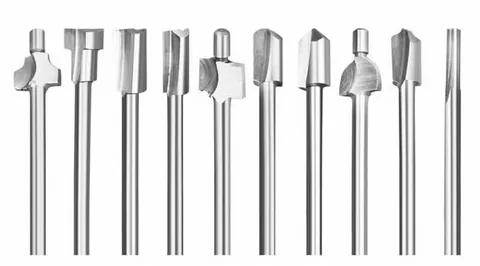CNC (Computer Numerical Control) routers have transformed the way hobbyists and professionals approach woodworking, plastics, metals, and other materials. Whether you’re crafting intricate signage or cutting sheet materials for cabinetry, choosing the right router bit is essential for precision and efficiency. This guide introduces you to the most common CNC router bit types, their characteristics, and the specific applications for which they’re best suited.
Understanding router bit types is fundamental for any CNC machine user, especially beginners. Selecting the wrong bit can lead to rough edges, burned material, excessive wear on the bit, or even damage to your machine. With a wide variety of bits available on the market, learning about their differences and purposes will help you make smarter project decisions and improve your overall results.
What Are CNC Router Bits and Why Are They Important?
CNC router bits are the cutting tools used in CNC machines to remove material from a workpiece. These bits rotate at high speeds and follow programmed toolpaths to create shapes, designs, and holes in a wide range of materials. The effectiveness and precision of a CNC project largely depend on selecting the right router bit. Every bit type has its own geometry, flute design, and material makeup that influence how it interacts with the substrate.
Understanding CNC router bit types is not just about knowing their names—it’s about recognizing what each one does best. From engraving fine details to slicing through thick MDF, every bit plays a specific role. Just like using the correct wrench size in mechanical work, the proper router bit ensures clean cuts, optimal machine performance, and longevity of both the tool and the machine.
Common CNC Router Bit Types and Their Features
There are several primary CNC router bit types, each designed for specific cutting, engraving, or shaping tasks. The most commonly used ones include straight bits, spiral bits, ball nose bits, V-bits, and compression bits. Straight bits are known for their simplicity and are ideal for slotting and edge trimming, while spiral bits (up-cut or down-cut) provide smoother finishes and better chip removal.
Ball nose bits, with their rounded tips, are perfect for 3D contouring and carving intricate surfaces. V-bits, which come to a sharp point, are frequently used in sign-making and engraving to produce crisp, angular lines. Compression bits combine the benefits of up-cut and down-cut flutes, making them ideal for plywood and laminate cutting without splintering the surface. Familiarizing yourself with these CNC router bit types helps match your tooling to your project’s material and detail level.
Each type of router bit also comes in various sizes and materials—typically high-speed steel (HSS), carbide, or diamond-coated. Carbide bits, though more expensive, offer longer life and better performance, especially for dense or abrasive materials. The number and direction of flutes (cutting edges) also affect performance: more flutes mean smoother finishes, while fewer flutes allow faster cutting with better chip clearance.
Choosing the Right Bit for the Material
Not all CNC router bit types perform well on every material. The key to high-quality results lies in understanding material characteristics and matching them to the appropriate bit. For example, hardwoods like oak or maple require robust, sharp bits with slower feed rates, while softwoods can be machined more aggressively with standard straight or spiral bits. Plastics such as acrylics need single-flute or O-flute bits to prevent melting and ensure clean edges.
Working with aluminum or composite materials presents another challenge. Specialized bits with polished cutting surfaces and specific flute geometries are required to avoid chip welding and ensure smooth results. If you’re cutting plywood, a compression bit can help eliminate tear-out on both the top and bottom surfaces. By understanding which CNC router bit types work best with specific materials, beginners can reduce trial-and-error and protect their investments in both materials and tools.
Another important factor is the bit coating and sharpness. Coated bits (like TiN or TiCN coatings) can improve lifespan and reduce friction when cutting metal or composite materials. Uncoated bits may be better suited for soft materials but will dull faster. Keeping a sharp and appropriate bit for your material not only improves the finish but also reduces stress on the CNC spindle and improves overall safety during machining.
Applications of Different Router Bit Types
Each of the main CNC router bit types excels in specific applications, and knowing these can help you choose the right one for your project. V-bits are excellent for engraving, inlay work, and sign making due to their ability to create sharp lines and variable-depth cuts. Ball nose bits are the go-to tools for 3D carving, as their rounded ends can follow curves and create smooth contours in materials like foam, wood, and plastic.
Straight and spiral bits are used widely in cabinetry and joinery for tasks like dadoing, grooving, and cutting sheet stock. Spiral bits are often preferred for their smoother finishes and better chip evacuation. Compression bits are best suited for tasks where edge finish is critical on both sides of the material, such as cutting laminated boards for furniture. By understanding these specific applications, you can confidently select the most effective CNC router bit types to meet your design goals.
In production environments or batch processing, the choice of router bits can significantly impact productivity. Bits designed for longer tool life and consistent cutting (like solid carbide compression bits) are essential. Conversely, for quick prototyping or one-off jobs, more affordable HSS bits might be sufficient. Matching bit selection with the project’s complexity, precision requirements, and material type leads to better quality and reduced wear and tear on your CNC machine.
Maintenance, Storage, and Tips for Beginners
Proper care of your CNC router bit types ensures longevity, safety, and continued precision. Beginners often overlook bit maintenance, which leads to poor cutting performance and potential material waste. After every use, bits should be cleaned of resin and debris using a non-abrasive cleaner. Dull bits should either be sharpened with specialized tools or replaced promptly to avoid damaging your materials or the CNC itself.
Storage is another often-neglected aspect. Keeping your bits in a dedicated case or rack—where they don’t touch each other—prevents chipping and extends their lifespan. Also, always store bits in a dry environment to avoid corrosion. For beginners, labeling each bit according to its type and use can save time and confusion later. It’s also wise to create a chart of your commonly used CNC router bit types, including their ideal RPMs, feed rates, and suitable materials.
Lastly, beginners should take time to test different bits on scrap material before committing to the final workpiece. This helps fine-tune settings like spindle speed, feed rate, and cutting depth. Always consult your CNC software’s tooling database for recommended parameters. As you gain experience, you’ll develop a deeper understanding of how each bit interacts with different materials—transforming your projects from rough prototypes into professional-quality work.
Final Thoughts
Starting out with a CNC router can feel overwhelming, but understanding the different CNC router bit types and their specific applications lays a strong foundation. From the precise engraving capabilities of V-bits to the powerful shearing action of spiral and compression bits, every tool has its place in the CNC workshop. Knowing which one to use—and how to care for it—empowers you to take on a wide range of creative and technical challenges.
As you gain more hands-on experience, your ability to select the right bit, adjust machine parameters, and interpret results will improve dramatically. Don’t hesitate to experiment and learn from each project. With practice and the right knowledge about CNC router bit types, even a complete beginner can achieve clean cuts, efficient production, and exceptional craftsmanship.








































